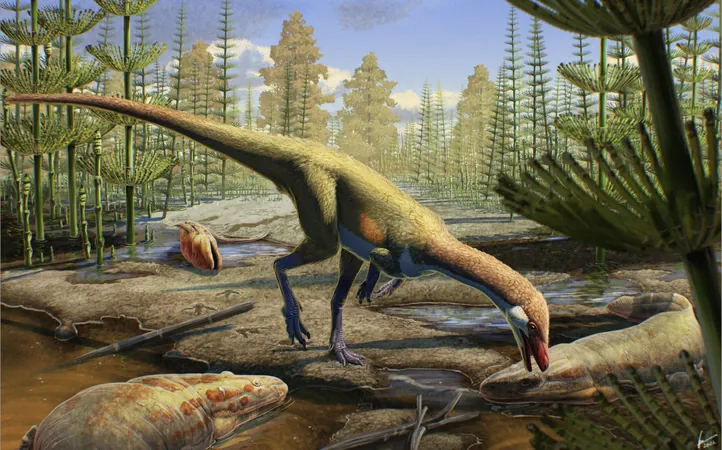
Dinosaurs Roamed North America Sooner Than We Thought: Shocking New Findings!
2025-01-08
Author: Sophie
In a groundbreaking discovery that challenges long-held beliefs about the early spread of dinosaurs, paleontologists at the University of Wisconsin–Madison have unveiled evidence indicating that dinosaurs may have inhabited the northern hemisphere millions of years earlier than previously believed. For decades, researchers grappled with the puzzle of when and how dinosaurs first emerged over 200 million years ago, often relying on an incomplete fossil record that painted an unclear picture.
Traditionally, scientists posited that dinosaurs originated from the southern part of the ancient supercontinent Pangea, known as Gondwana, before migrating to the northern section, Laurasia. However, the recent identification of a new dinosaur, Ahvaytum bahndooiveche, suggests that these reptiles were already thriving in the northern hemisphere as early as 230 million years ago, contemporaneous with the first known Gondwanan dinosaurs.
Discovered in Wyoming—the site where fossils were unearthed in 2013—Ahvaytum bahndooiveche is poised to change our understanding of dinosaur evolution. This diminutive dinosaur, comparable in size to a chicken but with a long, whip-like tail, is now recognized as North America's oldest dinosaur. Researchers concluded that while they don't possess a complete skeleton—an exceedingly rare find for early dinosaurs—they have enough fossilized leg remains to confirm it as a distinct species, likely a very early relative of the famed sauropods.
Sauropods are well-known for their enormous size and herbivorous diet, including giants like the titanosaurs. In contrast, Ahvaytum bahndooiveche was significantly smaller, standing just over one foot tall and measuring around three feet long from head to tail. Although the skull has not been found, closely related species typically consumed a varied diet, leading scientists to hypothesize that it too was likely omnivorous.
What makes this discovery even more compelling is its timing. Ahvaytum existed during the Carnian pluvial episode—a period (around 234 to 232 million years ago) known for significant climatic shifts that transformed hot, arid deserts into lush, fertile environments. These changes likely allowed early dinosaurs to flourish. The researchers employed advanced radioisotopic dating techniques to ascertain the age of the fossils, further reinforcing their findings that dinosaurs were already present in North America far earlier than previously documented.
Alongside this remarkable dinosaur, the team also uncovered tracks from early dinosaur-like creatures in slightly older rock formations, indicating that ancestors of dinosaurs were prowling the region even earlier. "We’ve unearthed crucial pieces of a larger puzzle that imply earlier dinosaur presence in the northern hemisphere," says Dave Lovelace, a lead researcher on the project.
On a culturally significant note, Ahvaytum bahndooiveche is also the first dinosaur species to be named in the language of the Eastern Shoshone Tribe. This collaboration reflects a growing trend within scientific research to incorporate Indigenous knowledge and engage local communities in the research process. Tribal elders and students played vital roles in the naming, which translates to "long ago dinosaur."
Amanda LeClair-Diaz, a co-author of the study and an educator with deep ties to the Eastern Shoshone and Northern Arapaho Tribes, emphasized the importance of this collaboration in reshaping how scientific research is conducted in Indigenous communities. “Traditionally, research has often been one-sided. Our cooperative work with Dr. Lovelace has paved the way for a mutual exchange of knowledge,” she states.
This significant find not only reshapes our understanding of dinosaur evolution but also highlights the importance of cultural collaboration in scientific discovery. As we continue to uncover the mysteries of our planet's history, who knows what else could be lurking beneath the surface? Stay tuned for more shocking revelations in the world of paleontology!



 Brasil (PT)
Brasil (PT)
 Canada (EN)
Canada (EN)
 Chile (ES)
Chile (ES)
 Česko (CS)
Česko (CS)
 대한민국 (KO)
대한민국 (KO)
 España (ES)
España (ES)
 France (FR)
France (FR)
 Hong Kong (EN)
Hong Kong (EN)
 Italia (IT)
Italia (IT)
 日本 (JA)
日本 (JA)
 Magyarország (HU)
Magyarország (HU)
 Norge (NO)
Norge (NO)
 Polska (PL)
Polska (PL)
 Schweiz (DE)
Schweiz (DE)
 Singapore (EN)
Singapore (EN)
 Sverige (SV)
Sverige (SV)
 Suomi (FI)
Suomi (FI)
 Türkiye (TR)
Türkiye (TR)
 الإمارات العربية المتحدة (AR)
الإمارات العربية المتحدة (AR)